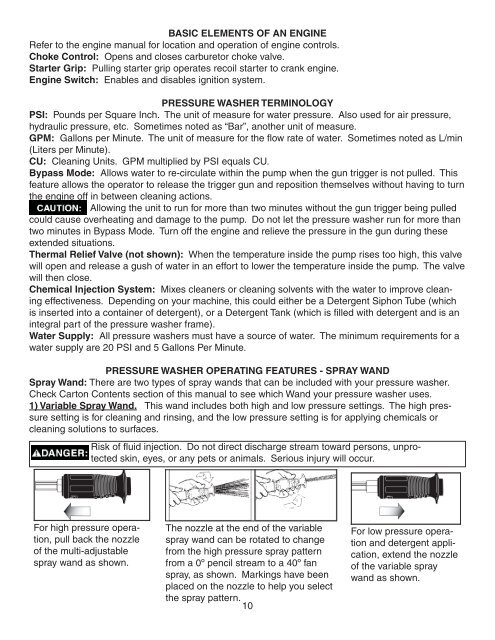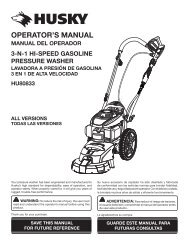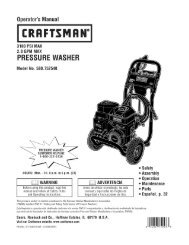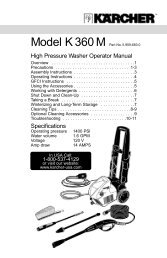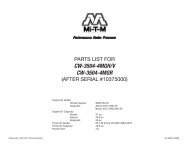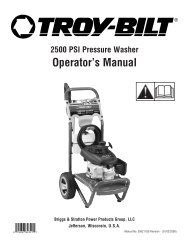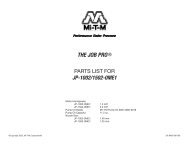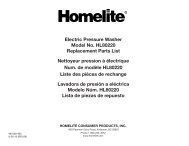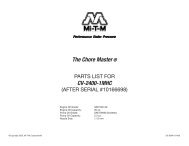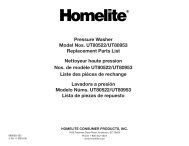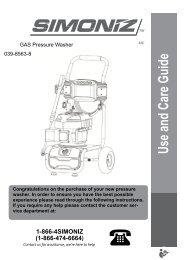MSV3100 Manual Rev 3.indd - Ppe-pressure-washer-parts.com
MSV3100 Manual Rev 3.indd - Ppe-pressure-washer-parts.com
MSV3100 Manual Rev 3.indd - Ppe-pressure-washer-parts.com
You also want an ePaper? Increase the reach of your titles
YUMPU automatically turns print PDFs into web optimized ePapers that Google loves.
BASIC ELEMENTS OF AN ENGINE<br />
Refer to the engine manual for location and operation of engine controls.<br />
Choke Control: Opens and closes carburetor choke valve.<br />
Starter Grip: Pulling starter grip operates recoil starter to crank engine.<br />
Engine Switch: Enables and disables ignition system.<br />
PRESSURE WASHER TERMINOLOGY<br />
PSI: Pounds per Square Inch. The unit of measure for water <strong>pressure</strong>. Also used for air <strong>pressure</strong>,<br />
hydraulic <strong>pressure</strong>, etc. Sometimes noted as “Bar”, another unit of measure.<br />
GPM: Gallons per Minute. The unit of measure for the fl ow rate of water. Sometimes noted as L/min<br />
(Liters per Minute).<br />
CU: Cleaning Units. GPM multiplied by PSI equals CU.<br />
Bypass Mode: Allows water to re-circulate within the pump when the gun trigger is not pulled. This<br />
feature allows the operator to release the trigger gun and reposition themselves without having to turn<br />
the engine off in between cleaning actions.<br />
Allowing the unit to run for more than two minutes without the gun trigger being pulled<br />
could cause overheating and damage to the pump. Do not let the <strong>pressure</strong> <strong>washer</strong> run for more than<br />
two minutes in Bypass Mode. Turn off the engine and relieve the <strong>pressure</strong> in the gun during these<br />
extended situations.<br />
Thermal Relief Valve (not shown): When the temperature inside the pump rises too high, this valve<br />
will open and release a gush of water in an effort to lower the temperature inside the pump. The valve<br />
will then close.<br />
Chemical Injection System: Mixes cleaners or cleaning solvents with the water to improve cleaning<br />
effectiveness. Depending on your machine, this could either be a Detergent Siphon Tube (which<br />
is inserted into a container of detergent), or a Detergent Tank (which is fi lled with detergent and is an<br />
integral part of the <strong>pressure</strong> <strong>washer</strong> frame).<br />
Water Supply: All <strong>pressure</strong> <strong>washer</strong>s must have a source of water. The minimum requirements for a<br />
water supply are 20 PSI and 5 Gallons Per Minute.<br />
PRESSURE WASHER OPERATING FEATURES - SPRAY WAND<br />
Spray Wand: There are two types of spray wands that can be included with your <strong>pressure</strong> <strong>washer</strong>.<br />
Check Carton Contents section of this manual to see which Wand your <strong>pressure</strong> <strong>washer</strong> uses.<br />
1) Variable Spray Wand. This wand includes both high and low <strong>pressure</strong> settings. The high <strong>pressure</strong><br />
setting is for cleaning and rinsing, and the low <strong>pressure</strong> setting is for applying chemicals or<br />
cleaning solutions to surfaces.<br />
Risk of fl uid injection. Do not direct discharge stream toward persons, unprotected<br />
skin, eyes, or any pets or animals. Serious injury will occur.<br />
For high <strong>pressure</strong> operation,<br />
pull back the nozzle<br />
of the multi-adjustable<br />
spray wand as shown.<br />
The nozzle at the end of the variable<br />
spray wand can be rotated to change<br />
from the high <strong>pressure</strong> spray pattern<br />
from a 0º pencil stream to a 40º fan<br />
spray, as shown. Markings have been<br />
placed on the nozzle to help you select<br />
the spray pattern.<br />
10<br />
For low <strong>pressure</strong> operation<br />
and detergent application,<br />
extend the nozzle<br />
of the variable spray<br />
wand as shown.


